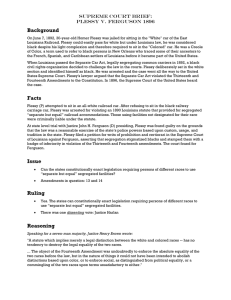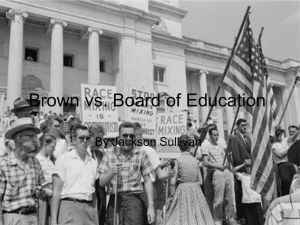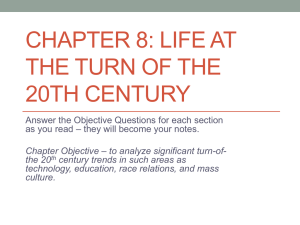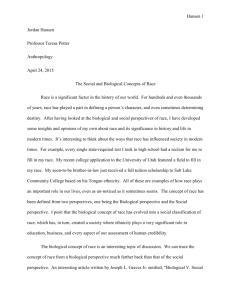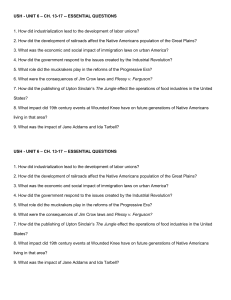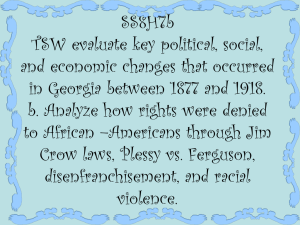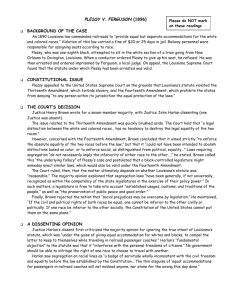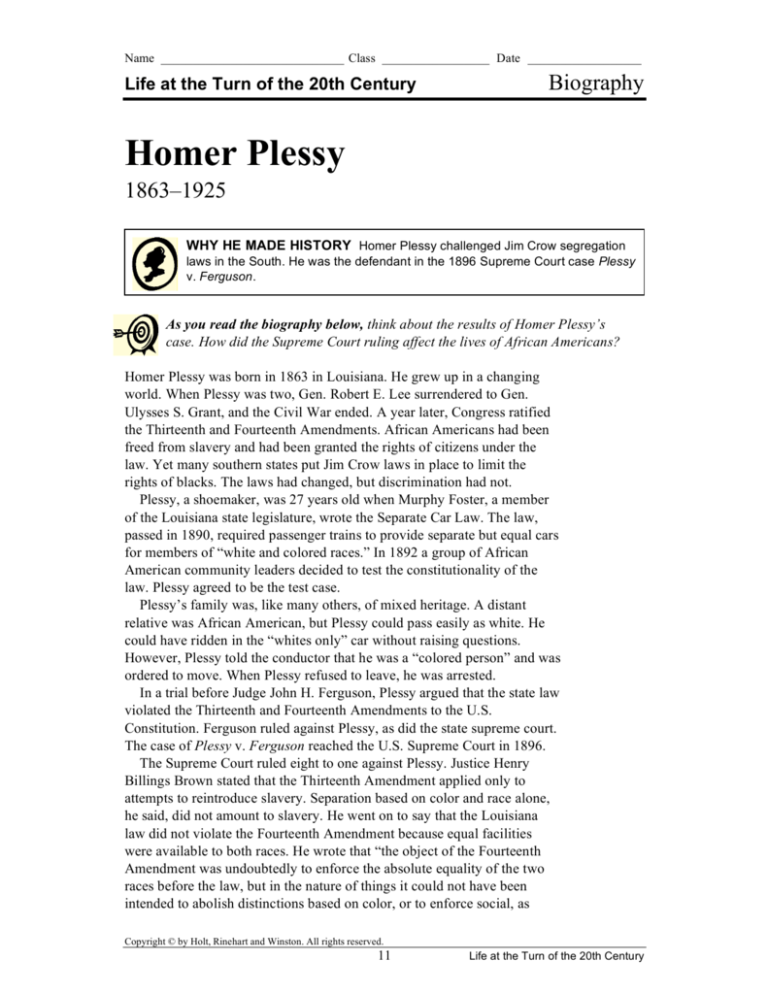
Name _____________________________ Class _________________ Date __________________
Life at the Turn of the 20th Century
Biography
Homer Plessy
1863–1925
WHY HE MADE HISTORY Homer Plessy challenged Jim Crow segregation
laws in the South. He was the defendant in the 1896 Supreme Court case Plessy
v. Ferguson.
As you read the biography below, think about the results of Homer Plessy’s
case. How did the Supreme Court ruling affect the lives of African Americans?
Homer Plessy was born in 1863 in Louisiana. He grew up in a changing
world. When Plessy was two, Gen. Robert E. Lee surrendered to Gen.
Ulysses S. Grant, and the Civil War ended. A year later, Congress ratified
the Thirteenth and Fourteenth Amendments. African Americans had been
freed from slavery and had been granted the rights of citizens under the
law. Yet many southern states put Jim Crow laws in place to limit the
rights of blacks. The laws had changed, but discrimination had not.
Plessy, a shoemaker, was 27 years old when Murphy Foster, a member
of the Louisiana state legislature, wrote the Separate Car Law. The law,
passed in 1890, required passenger trains to provide separate but equal cars
for members of “white and colored races.” In 1892 a group of African
American community leaders decided to test the constitutionality of the
law. Plessy agreed to be the test case.
Plessy’s family was, like many others, of mixed heritage. A distant
relative was African American, but Plessy could pass easily as white. He
could have ridden in the “whites only” car without raising questions.
However, Plessy told the conductor that he was a “colored person” and was
ordered to move. When Plessy refused to leave, he was arrested.
In a trial before Judge John H. Ferguson, Plessy argued that the state law
violated the Thirteenth and Fourteenth Amendments to the U.S.
Constitution. Ferguson ruled against Plessy, as did the state supreme court.
The case of Plessy v. Ferguson reached the U.S. Supreme Court in 1896.
The Supreme Court ruled eight to one against Plessy. Justice Henry
Billings Brown stated that the Thirteenth Amendment applied only to
attempts to reintroduce slavery. Separation based on color and race alone,
he said, did not amount to slavery. He went on to say that the Louisiana
law did not violate the Fourteenth Amendment because equal facilities
were available to both races. He wrote that “the object of the Fourteenth
Amendment was undoubtedly to enforce the absolute equality of the two
races before the law, but in the nature of things it could not have been
intended to abolish distinctions based on color, or to enforce social, as
Copyright © by Holt, Rinehart and Winston. All rights reserved.
11
Life at the Turn of the 20th Century
Name _____________________________ Class _________________ Date __________________
Biography
Life at the Turn of the 20th Century
distinguished from political equality . . . if the two races are to meet upon
terms of social equality, it must be the result of voluntary consent of the
individuals.” The court’s decision allowed states to continue to pass laws
to enforce a social separation of the races.
Justice John Marshall Harlan, a former Kentucky slaveholder, was the
only judge to vote in favor of Plessy. He wrote that segregation was a
“badge of servitude” and that “the Constitution is color-blind.”
Homer Plessy married in 1897 and became an insurance collector. He
lived quietly until his death in 1925. Plessy was buried in his mother’s
family tomb in New Orleans. Twenty-nine years after his death, the
Supreme Court issued a ruling that finally overturned “separate but
equal” laws.
WHAT DID YOU LEARN?
1. Recall Why did Plessy sit in a “whites only” car?
____________________________________________________________________
____________________________________________________________________
2. Make a Judgment Was Plessy’s act of civil disobedience successful? Why or
why not?
____________________________________________________________________
____________________________________________________________________
ACTIVITY
Read the Thirteenth and Fourteenth Amendments. Then read excerpts from
the Supreme Court rulings in Plessy v. Ferguson. Write your own ruling in
the case defending your position.
Copyright © by Holt, Rinehart and Winston. All rights reserved.
12
Life at the Turn of the 20th Century


